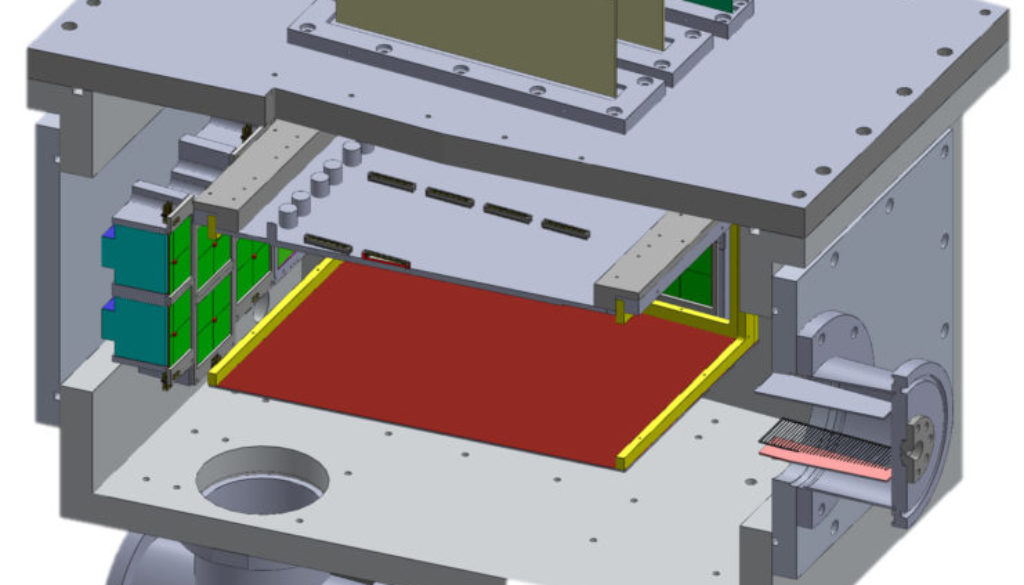Texas A&M-Led Study Reveals Diminished Role for Neutrons in Creation of Carbon in Stars
A Texas A&M University-led collaboration has yielded new insight into one of the universe’s most important primordial reactions that made all life on Earth possible.
The multi-institution team of nuclear scientists that also includes researchers from Washington University in St. Louis and Ohio University concluded in a recent study that the role neutrons play in the creation of carbon, considered the definitive building block of life, actually is much smaller than previously thought.
Their data, acquired during 2020 and analyzed within the past year, is detailed in a paper published Wednesday (Apr. 20) in Nature Communications.

“These findings are extremely significant because it demonstrates that the rate at which stars burn helium together to form carbon is less sensitive to any neutrons in the stars, which were previously thought to speed up this process,” said Dr. Jack Bishop, an assistant research scientist at the Texas A&M Cyclotron Institute and a lead author of the paper. “Understanding the way that stars burn is extremely important in understanding the life and death of stars, as well as where the elements that make up our universe originate from and in what quantity.”
The experiment specifically focused on the formation of carbon-12, which is produced inside the cores of dying stars in a rare phenomenon called the triple-alpha process where three alpha particles (helium-4 nuclei) collide and fuse. While scientists have long known the highly excited state of carbon produced as a result of this process emits gamma rays to achieve a stable condition (regular carbon-12), they have suspected that other particles also play a role in that de-excitation, specifically neutrons, which carry no electrical charge and can remove extra energy.
Because the reaction requires four particles — a neutron and three alpha particles — to occur within an extremely small volume of space comparable to the size of an atomic nucleus and a tiny time interval equal to a 10th of a femtosecond, directly measuring this process as it occurs in stars is essentially impossible. The team instead measured the probability of its inverse, breaking apart the carbon-12 with neutrons in a time-reversed reaction that effectively reverts the carbon-12 back to its three alpha particles.

Until recently, the probability for this process was estimated only theoretically, says Texas A&M physicist Dr. Grigory Rogachev, an expert in low-energy experimental nuclear physics and a principal investigator for the project.
“We now have the direct measurement, which provides accurate data on the probability of this process,” said Rogachev, head of the Texas A&M Department of Physics and Astronomy and a Cyclotron Institute member. “It turned out that the theoretical predictions for the probability of this neutron upscattering on carbon were off by more than one order of magnitude. The experimentally measured value is much smaller.”
To prove this, the team utilized a testing apparatus called the Texas Active Target, or TexAT — a specialized particle detector known as an active-target time-projection chamber that recently was constructed at the Cyclotron Institute. By firing beams of high-energy neutrons into the detector, they were able to blast apart carbon nuclei in carbon dioxide gas and observe the breakup pattern for a variety of different energies in three-dimensional renderings. The propensity of carbon-12 to break apart into three alpha particles indeed was seen to be lower and therefore much less important than expected, based on the previous theoretical models.
Learn how the TexAT detector works and the science behind the collaboration’s hypothesis in this 2020 video on the Texas A&M Science YouTube channel:
Ohio University nuclear astrophysicist Dr. Carl Brune oversaw beam testing at his institution’s 17,400-square-foot John E. Edwards Accelerator Laboratory, which boasts a rare 4.5 million-volt tandem accelerator capable of discharging atomic particles to energies up to 14 percent of the speed of light.
“Here at Ohio University, we are proud that our unique neutron science capabilities — an intense and well-characterized neutron beam in this case — made a significant contribution to this outstanding new science result,” Brune said. “It is very satisfying to see a multi-institution collaboration like this be successful.”
Approximately 5,000 neutrons per second were fired into TexAT, with only about one in a million of them rendering a reverse triple-alpha process — roughly one occurrence every five minutes. Texas A&M Cyclotron Institute postdoctoral research associate Dr. Cody Parker, a key member of the collaboration with expertise in neutron detector development, assisted the Ohio team with optimizing the neutron beam for precise measurement.
“Performing neutron-induced reactions is a complicated effort and not something you can do every day, because you can’t simply make a neutron beam,” Parker said. “A lot of people were involved in making this possible. We’re grateful for their contributions and are pleased with the outcome.”
Washington University nuclear chemist and principal investigator Dr. Lee Sobotka first proposed the idea of utilizing a time-projection chamber to determine the influence of neutrons on the triple-alpha process to his co-collaborators in 2017. Time-projection chambers like TexAT typically are used to construct visual renderings of the trajectories of rare isotope beams and the products of nuclear reactions induced by those beams. Using one to explore nuclear reactions with neutrons as in this instance, however, is an undertaking that’s never before been done.
“This experiment married a very special tool — an active-target time-projection chamber — with a low-energy accelerator capable of producing near mono-energetic neutrons,” Sobotka said. “It’s a first-of-its-kind union that provided the answer to a question first posed 55 years ago on the making of the seed for heavy-element synthesis.”
The team’s paper, “Neutron-upscattering enhancement of the triple-alpha process,” can be viewed online along with related figures and captions. Their work was supported by the Department of Energy’s National Nuclear Security Administration and Office of Science, the National Science Foundation, the Science and Technology Facilities Council and the Center for Excellence in Nuclear Training and University-based Research (CENTAUR), a multi-institutional effort led by Texas A&M that seeks to support collaborative research efforts in the area of low-energy nuclear science.
To learn more about Rogachev and his research group, visit https://physics.tamu.edu/directory/grigory-rogachev/.
See additional photographs of TexAT and the Texas A&M team’s 2020 trip to Ohio, courtesy of Jack Bishop.
# # # # # # # # # #
About the Cyclotron Institute: Dedicated in 1967, the Cyclotron Institute serves as the core of Texas A&M University’s accelerator-based nuclear science and technology program. Affiliated faculty members from the Department of Chemistry and the Department of Physics and Astronomy conduct nuclear physics- and chemistry-based research and radiation testing within a broad-based, globally recognized interdisciplinary platform supported by the United States Department of Energy (DOE) in conjunction with the State of Texas and the Welch Foundation. The facility is one of five DOE-designated Centers of Excellence and is home to one of only five K500 or larger superconducting cyclotrons worldwide. To learn more, visit https://cyclotron.tamu.edu/.
About CENTAUR: The Center for Excellence in Nuclear Training And University-based Research (CENTAUR) is a multi-institutional effort supported by a five-year, $10 million Stewardship Science Academic Alliances (SSAA) grant from the Department of Energy’s National Nuclear Security Administration (DOE/NNSA). CENTAUR pursues basic research in low-energy nuclear science through experimental, theoretical and technical programs using accelerators at Texas A&M’s Cyclotron Institute and Florida State University’s John D. Fox Superconducting Linear Accelerator Laboratory as well as facilities at the other partner institutions, which include Texas A&M University, Florida State University, Washington University in St. Louis, the University of Washington, Louisiana State University and the University of Notre Dame. To learn more, visit https://centaur.tamu.edu/.
About Research at Texas A&M University: As one of the world’s leading research institutions, Texas A&M is at the forefront in making significant contributions to scholarship and discovery, including science and technology. Research conducted at Texas A&M generated annual expenditures of more than $1.131 billion in fiscal year 2020. Texas A&M ranked in the top 25 of the most recent National Science Foundation Higher Education Research and Development survey based on expenditures of more than $952 million in fiscal year 2019. Texas A&M’s research creates new knowledge that provides basic, fundamental, and applied contributions resulting in economic benefits to the state, nation, and world. To learn more, visit Research@Texas A&M.
-aTm-
Contact: Chris Jarvis, (979) 845-7246 or cjarvis@science.tamu.edu, or Dr. Grigory Rogachev, (979) 458-0349 or rogachev@ tamu.edu
The post Texas A&M-Led Study Reveals Diminished Role for Neutrons in Creation of Carbon in Stars appeared first on Texas A&M College of Science.
